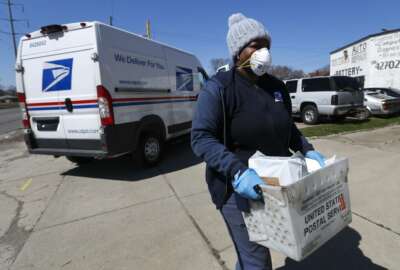Best listening experience is on Chrome, Firefox or Safari. Subscribe to Federal Drive’s daily audio interviews on Apple Podcasts or PodcastOne.
The Postal Service delivered more than a billion packages during its peak holiday season, but Postmaster General Louis DeJoy said the agency fell far short of meeting its service targets, and left some customers waiting weeks for mail and packages.
Despite hiring an additional 50,000 seasonal workers and 10,000 full-time employees to keep up with demand and make up for shortfalls in employee availability, DeJoy apologized to the agency’s customers and called the delays “unacceptable.”
“All in all, we threw everything we had at it — no cost-cutting, no efficiency initiatives, no relaxation of any effort anywhere — and yet we missed our service standards by far and disappointed the nation,” DeJoy said Tuesday in a meeting of the USPS Board of Governors.
USPS delivered 78.44% of first-class mail on time in the first quarter of FY 2021, compared to 90.37% on time for the same quarter in FY 2020.
While the COVID-19 pandemic has strained USPS operations and caused it to fall short of its service standards, DeJoy said these challenges aren’t new, and that the agency hasn’t met its services standards over the past eight years.
“While our service performance issues have deservedly captured a lot of recent attention, the problems underlying them stretch back for many years and are a prelude to what will be coming if changes are not soon made,” DeJoy said.
However, the holiday season also became a financial windfall for USPS in the first quarter of fiscal 2021. The surge in packages contributed to a $2.1 billion increase in revenue — 11% higher than revenue for the same period in fiscal 2020. In addition, USPS reported $318 million in net income for the quarter.
If USPS doesn’t stabilize its service reliability and improve its financial outlook, DeJoy warned the agency’s universal service obligation to deliver mail to nearly every U.S. household six days a week will be threatened.
To put USPS on a long-term sustainable path, DeJoy said the agency will soon release a 10-year strategy focused on upgrading its aging infrastructure.
“For too many years, postal employees have been asked to do more with less — forced to employ antiquated systems, utilize outmoded equipment and drive outdated vehicles. This drives up costs and slows down service for our customers. We cannot afford to keep this up,” DeJoy said.
The strategy, he said, includes plans for a new delivery vehicle fleet and package sortation equipment at processing plants. The plan also focuses on strengthening the USPS workforce, especially for workers in non-career positions.
“We want every postal employee to have the tools, training and supportive environment necessary to enjoy a long-term career with us. We want them to feel empowered,” DeJoy said.
In addition, the strategy will keep six-day mail delivery in place.
New USPS leadership will assist DeJoy in the rollout of this strategy. The USPS Board of Governors elected Ron Bloom, a former senior Treasury Department official during the Obama administration, to serve as its next chairman.
Bloom, one of two Democrats on the board, is serving the remainder of a term that expired in December, but is eligible to stay on the board for an additional holdover year.
The board elected Bloom to its top position after former chairman Robert “Mike” Duncan, a Republican, announced that he wouldn’t opt for re-election, but will stay on the board through the end of his term, which ends in December 2025.
Bloom has led the board’s strategy and innovation committee, which spearheaded the 10-year strategy effort, and has encouraged USPS management to develop pricing and promotion strategies for its small-business customers.
“Our current level of service is acceptable to no one at the Postal Service,” Bloom said about current the agency’s delays, adding that the 10-year strategy will present a “bold and comprehensive” reform plan for the agency in the coming weeks.
Despite the toll of the COVID-19 pandemic has taken on the agency’s workforce, USPS saw a record-breaking 25% increase in package volume for the first quarter of fiscal 2021 and a $2.1 billion increase in revenue compared to the previous year.
For the peak holiday season alone, USPS Chief Financial Officer Joe Corbett said the agency saw a 40% increase in package volumes.
“We’ve never been anywhere near that level,” Corbett said.
While the increased shipping revenue has improved the agency’s short-term financial outlook, Corbett said USPS expects the surge in packages to level out later this year as the economy opens back up.
In the long-term, USPS doesn’t expect the temporary surge in packages will make up for a loss in mail volume caused by the pandemic.
Corbett compared the current drop in the mail to the 20% decrease in volume USPS saw during the 2008 Great Recession, which became the “new norm” for mail volume afterward.
“We believe it is unlikely that letter volumes will fully recover to pre-pandemic levels,” Corbett said.
Fredric Rolando, president of the National Association of Letter Carriers, said in a statement that increased postal revenue reflects “the essential work and value of the USPS over the past year and counting,” given the increased challenges from the pandemic.
“Letter carriers have helped tens of millions of Americans shelter safely at home and even vote from home. Perhaps never in its 245 years has the public post office been more indispensable,” Rolando said.
Copyright
© 2024 Federal News Network. All rights reserved. This website is not intended for users located within the European Economic Area.
